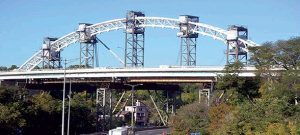Background Information and Challenge
The Burgoyne Bridge in the Niagara region serves as a vital connection between downtown St. Catharines and the city’s west end. Spanning 400 meters, the bridge crosses the 12-mile creek, Highway 412, and sensitive fish habitats and conservation areas. Built in 1912, the bridge faced years of degradation and increased demands, prompting the need for repair or replacement. An engineer assessed its useful life at approximately seven years in its current state. Consequently, we decided to replace the entire structure with a new, modern bridge system designed to last for many years.
The decision to replace the Burgoyne Bridge stemmed from both structural and environmental concerns. A geotechnical survey revealed significant soil settlement over bedrock. To address this, we needed a lightweight fill like Expanded Polystyrene. However, we also required a geomembrane protection layer to guard against degradation from liquid hydrocarbons such as diesel, gasoline, kerosene, and hydraulic fluid. The geomembrane lining system had to endure the long-term design of the structure (over 100 years), withstand primary contact with hydrocarbons, and flexibly conform to the 90-degree corners and angles of the EPS. Layfield proposed the Enviro Liner® 6040 Geomembrane liner for the application.
Solution
Layfield manufactures, fabricates, and installs Enviro Liner® 6040, a flexible, fortified LLDPE/HDPE geomembrane lining system. Prime-grade resins and antioxidants are used to ensure long-term, reliable protection. The lining system offers excellent chemical-resistant properties, making it suitable for containing solvent and water vapors. To satisfy the client, Layfield completed independent permeability testing for various popular fuels. The membrane resists puncture and backfilling in an under-slab application. Its flexible properties allowed Layfield to prefabricate and tailor the fit to wrap the EPS blocks.
Layfield installation crews completed the lining system in two phases. Firstly, they handled the abutment in phase one, and then the abutment in phase two. Layfield used a combination of prefabricated shop-fabricated Enviro Liner® 6040 panels and roll stock fusion welded on-site. Split wedge welding enabled them to pressure test the seam for any leakage. Layfield closely coordinated with the site contractor to manage the installation schedule.
Results
Our crews completed the project on time and on schedule with the contractor. However, coordinating closely with the contractor’s unpredictable construction schedule made the task particularly challenging. Both the owner and the contractor enjoyed working with Layfield and look forward to collaborating on future projects.
